Jackson’s Chameleon
- January 5, 2024
- 0 comment
Jackson’s Chameleon, scientifically known as Trioceros jacksonii, is a captivating reptile that holds a unique place in the world of chameleons. Discovered by the eminent British biologist George Albert Boulenger in 1896, these remarkable creatures are native to the montane regions of Kenya, Tanzania, and Uganda, thriving in altitudes ranging from 1,500 to 2,400 meters. What sets Jackson’s Chameleon apart is its distinctive tri-horned appearance and the fascinating ability to change color. In their natural habitat, characterized by dense vegetation, they exhibit a diverse range of colors influenced by emotions, temperature, and surroundings.

These chameleons primarily feed on insects, spiders, and small invertebrates, using their independently moving eyes and specialized tongues for precise and rapid strikes. What makes Jackson’s Chameleon even more intriguing is their reproductive strategy, involving intricate mating rituals and live births. As captivating pets, they require specialized care, facing challenges like stress and specific health concerns. While not classified as endangered, conservation efforts are crucial due to threats from habitat destruction and the pet trade. Beyond their biological significance, Jackson’s Chameleons play a role in folklore and cultural beliefs, symbolizing adaptability and resilience in various communities. In essence, Jackson’s Chameleon is a colorful marvel of nature, offering a blend of unique characteristics and ecological importance.
| Specification | Details |
|---|---|
| Scientific Name | Trioceros jacksonii |
| Common Name | Jackson’s Chameleon |
| Discovery Year | 1896 |
| Native Regions | Kenya, Tanzania, Uganda |
| Altitude Range | 1,500 to 2,400 meters |
| Physical Features | Tri-horned appearance, color-changing ability |
| Diet | Insects, spiders, small invertebrates |
| Hunting Technique | Deliberate approach, rapid tongue strikes |
| Reproductive Strategy | Live births, intricate mating rituals |
| Pet Care Requirements | Specialized care, humidity maintenance, suitable environment |
| Lifespan (in captivity) | 5 to 10 years |
| Conservation Status | Not endangered, but faces threats from habitat destruction |
| Conservation Efforts | Habitat preservation, regulation of pet trade |
| Cultural Symbolism | Varied folklore, symbolizes adaptability and resilience |
| Contribution to Research | Studied for color-changing mechanisms, reproductive strategies |
| Challenges in Study | Elusive behavior in the wild, limited behavioral observations |
| Interesting Facts | Independently moving eyes, 360-degree field of vision |
A Colorful Marvel of Nature
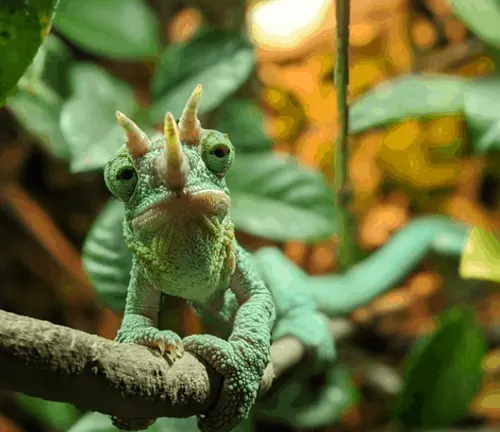
Jackson’s Chameleon, scientifically known as Trioceros jacksonii, stands as a captivating marvel in the world of reptiles. Discovered in 1896 by the renowned British biologist George Albert Boulenger, these remarkable creatures boast unique features that set them apart from other chameleon species.
Habitat and Distribution
Native to the montane regions of Kenya, Tanzania, and Uganda, Jackson’s Chameleon thrives in the mountainous terrains with altitudes ranging from 1,500 to 2,400 meters. Their natural habitat consists of dense vegetation, providing them with the perfect cover for their distinct lifestyle.


Physical Characteristics
What truly distinguishes Jackson’s Chameleon is its tri-horned appearance and the ability to change color. These chameleons exhibit a wide range of colors, primarily influenced by their emotions, temperature, and surrounding environment. Their unique horns, a feature not found in all chameleon species, add an extra layer of fascination.
Diet and Feeding Habits
In the wild, Jackson’s Chameleon primarily feeds on insects, spiders, and other small invertebrates. Their hunting technique involves a slow, deliberate approach, utilizing their independently moving eyes to locate prey. This particular chameleon’s tongue is equipped with a specialized mechanism for accurate and rapid strikes.
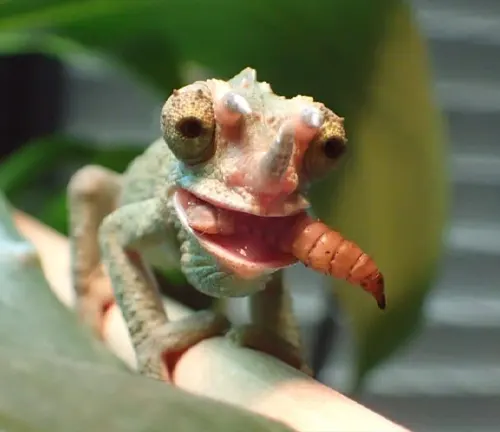

Reproduction and Lifecycle
The mating rituals of Jackson’s Chameleon involve intricate displays of color-changing and body language. Females give birth to live young, a distinctive trait among chameleon species. The gestation period and nurturing of the offspring provide further insights into the complex reproductive strategy of these reptiles.
Adaptations to Captivity
As exotic pets, Jackson’s Chameleons require specialized care. Maintaining proper humidity, providing a diverse diet, and creating a suitable environment with climbing opportunities are essential for their well-being. Overcoming challenges such as stress and specific health concerns is crucial for their successful captivity.
Common Health Issues
Ensuring the health of Jackson’s Chameleon involves understanding common issues such as respiratory infections and metabolic bone disease. Regular veterinary check-ups, a balanced diet, and maintaining optimal living conditions contribute significantly to their longevity in captivity.

Conservation Status
While not classified as endangered, Jackson’s Chameleon faces threats from habitat destruction, deforestation, and the pet trade. Various conservation efforts aim to protect their natural habitats and regulate the trade of these unique reptiles.
Interaction with Humans
In local folklore and cultural beliefs, Jackson’s Chameleon often symbolizes adaptability and resilience. Some communities view them as spiritual creatures with mystical significance. The impact of these reptiles on local communities, both positive and negative, highlights the intricate relationship between humans and wildlife.
Interesting Facts about Jackson’s Chameleon
Beyond their appearance and behavior, Jackson’s Chameleons have fascinating traits, including their ability to move both eyes independently, a 360-degree field of vision, and the capacity to rotate their eyes in different directions simultaneously.
Comparison with Other Chameleon Species
When compared to other chameleon species, Jackson’s Chameleon stands out with its tri-horned appearance, unique color patterns, and live birth. Ecologically, their preference for higher altitudes and specific vegetation distinguishes them from their counterparts.
Educational and Research Significance
These captivating reptiles contribute significantly to scientific studies on color-changing mechanisms, reproductive strategies, and adaptation to varying environments. Their presence in educational programs enhances students’ understanding of biodiversity and conservation.
Different Species
Jackson’s Chameleon
(Trioceros jacksonii jacksonii)
This is the nominate subspecies and is commonly found in Kenya. It exhibits a distinctive tri-horned appearance and the ability to change colors.
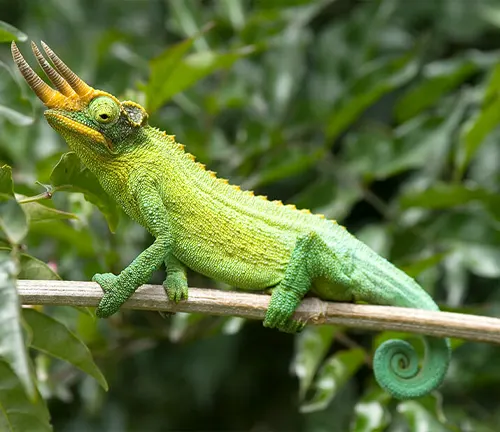
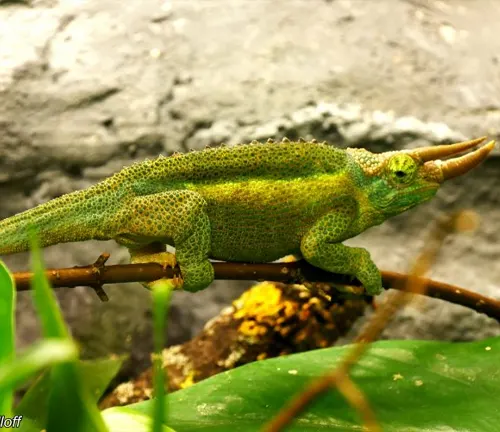
Moor’s Chameleon
(Trioceros jacksonii xanthalophus)
Native to the Aberdare Range in Kenya, Moor’s Chameleon is a subspecies with a broader range of colors and patterns. It often lacks the tri-horned appearance seen in the nominate subspecies.
Mt. Meru Chameleon
(Trioceros jacksonii merumontanus)
Found in Tanzania, specifically around Mt. Meru, this subspecies is characterized by a less pronounced tri-horned structure. It shares similarities with both the nominate subspecies and Moor’s Chameleon.
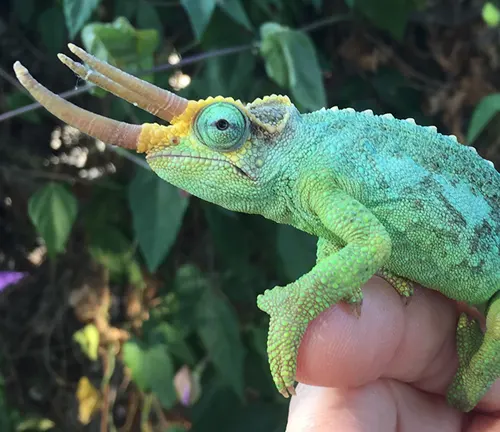
Frequently Asked Questions (FAQs)
- Can I keep Jackson’s Chameleon as a pet?
Yes, Jackson’s Chameleons can be kept as pets, but they require specialized care. - What is the average lifespan of a Jackson’s Chameleon?
In captivity, they typically live for about 5 to 10 years, depending on care and environment. - Do all Jackson’s Chameleons have horns?
No, not all individuals have tri-horns. The presence of horns can vary among individuals. - How often do Jackson’s Chameleons change color?
They can change color frequently throughout the day, influenced by mood, temperature, and environment. - What is their natural habitat like?
Jackson’s Chameleons are native to montane regions in Kenya, Tanzania, and Uganda, preferring altitudes between 1,500 to 2,400 meters. - Are they endangered?
While not currently classified as endangered, they face threats from habitat destruction and the pet trade. - What do Jackson’s Chameleons eat?
Their diet primarily consists of insects, spiders, and small invertebrates. - Can they live in groups or pairs?
Jackson’s Chameleons are generally solitary creatures and should be housed individually to avoid stress. - Do they require a specific humidity level?
Yes, maintaining proper humidity is crucial for their well-being, especially in captivity. - What kind of environment do they need in captivity?
They need a well-ventilated enclosure with climbing opportunities, suitable lighting, and a balanced diet. - Are there specific health concerns for Jackson’s Chameleons?
Yes, common health issues include respiratory infections and metabolic bone disease. Regular veterinary check-ups are essential. - Can Jackson’s Chameleons live in different climates?
They are adapted to specific montane climates, and replicating these conditions is crucial for their health in captivity. - What is their behavior like in the wild?
In the wild, they exhibit elusive behavior, blending into their surroundings and relying on their color-changing abilities for camouflage. - Can I release a captive-bred Jackson’s Chameleon into the wild?
Releasing captive-bred chameleons into the wild is discouraged, as it can impact the local ecosystem. - How do Jackson’s Chameleons communicate?
They communicate through body language, color changes, and specific movements, especially during mating rituals.



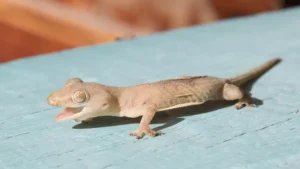
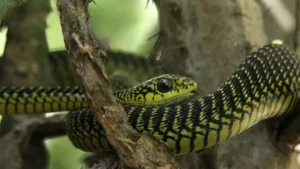
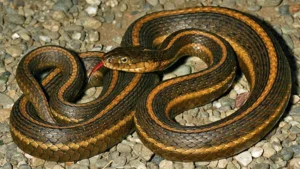
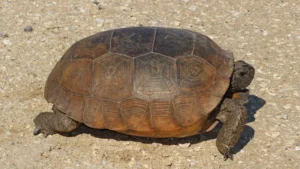


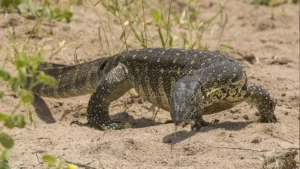

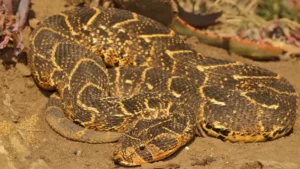
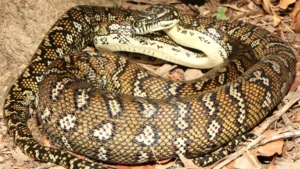
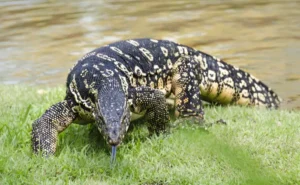
Leave your comment